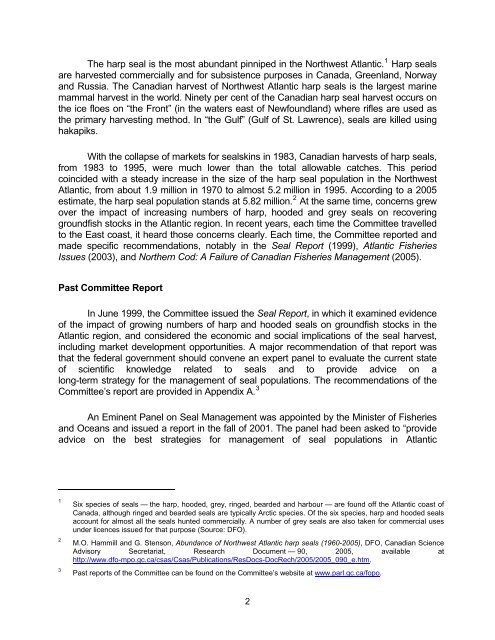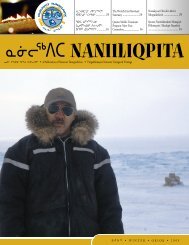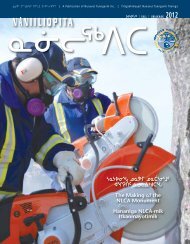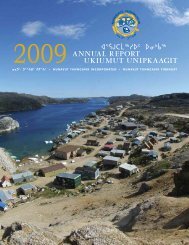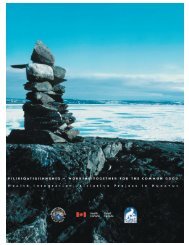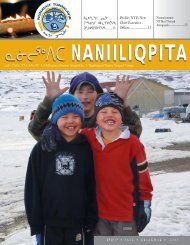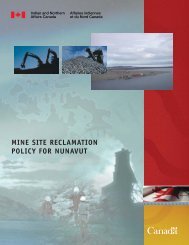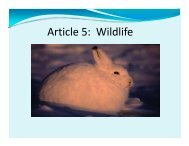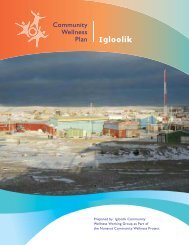Ensuring a Sustainable and Humane Seal Harvest - Nunavut ...
Ensuring a Sustainable and Humane Seal Harvest - Nunavut ...
Ensuring a Sustainable and Humane Seal Harvest - Nunavut ...
You also want an ePaper? Increase the reach of your titles
YUMPU automatically turns print PDFs into web optimized ePapers that Google loves.
The harp seal is the most abundant pinniped in the Northwest Atlantic. 1 Harp sealsare harvested commercially <strong>and</strong> for subsistence purposes in Canada, Greenl<strong>and</strong>, Norway<strong>and</strong> Russia. The Canadian harvest of Northwest Atlantic harp seals is the largest marinemammal harvest in the world. Ninety per cent of the Canadian harp seal harvest occurs onthe ice floes on “the Front” (in the waters east of Newfoundl<strong>and</strong>) where rifles are used asthe primary harvesting method. In “the Gulf” (Gulf of St. Lawrence), seals are killed usinghakapiks.With the collapse of markets for sealskins in 1983, Canadian harvests of harp seals,from 1983 to 1995, were much lower than the total allowable catches. This periodcoincided with a steady increase in the size of the harp seal population in the NorthwestAtlantic, from about 1.9 million in 1970 to almost 5.2 million in 1995. According to a 2005estimate, the harp seal population st<strong>and</strong>s at 5.82 million. 2 At the same time, concerns grewover the impact of increasing numbers of harp, hooded <strong>and</strong> grey seals on recoveringgroundfish stocks in the Atlantic region. In recent years, each time the Committee travelledto the East coast, it heard those concerns clearly. Each time, the Committee reported <strong>and</strong>made specific recommendations, notably in the <strong>Seal</strong> Report (1999), Atlantic FisheriesIssues (2003), <strong>and</strong> Northern Cod: A Failure of Canadian Fisheries Management (2005).Past Committee ReportIn June 1999, the Committee issued the <strong>Seal</strong> Report, in which it examined evidenceof the impact of growing numbers of harp <strong>and</strong> hooded seals on groundfish stocks in theAtlantic region, <strong>and</strong> considered the economic <strong>and</strong> social implications of the seal harvest,including market development opportunities. A major recommendation of that report wasthat the federal government should convene an expert panel to evaluate the current stateof scientific knowledge related to seals <strong>and</strong> to provide advice on along-term strategy for the management of seal populations. The recommendations of theCommittee’s report are provided in Appendix A. 3An Eminent Panel on <strong>Seal</strong> Management was appointed by the Minister of Fisheries<strong>and</strong> Oceans <strong>and</strong> issued a report in the fall of 2001. The panel had been asked to “provideadvice on the best strategies for management of seal populations in Atlantic123Six species of seals — the harp, hooded, grey, ringed, bearded <strong>and</strong> harbour — are found off the Atlantic coast ofCanada, although ringed <strong>and</strong> bearded seals are typically Arctic species. Of the six species, harp <strong>and</strong> hooded sealsaccount for almost all the seals hunted commercially. A number of grey seals are also taken for commercial usesunder licences issued for that purpose (Source: DFO).M.O. Hammill <strong>and</strong> G. Stenson, Abundance of Northwest Atlantic harp seals (1960-2005), DFO, Canadian ScienceAdvisory Secretariat, Research Document — 90, 2005, available athttp://www.dfo-mpo.gc.ca/csas/Csas/Publications/ResDocs-DocRech/2005/2005_090_e.htm.Past reports of the Committee can be found on the Committee’s website at www.parl.gc.ca/fopo.2


